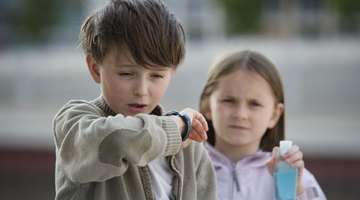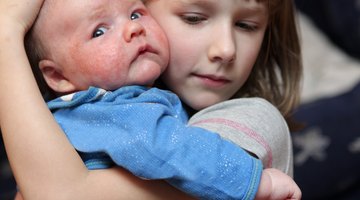How to Differentiate Between Bronchiolitis and Pneumonia in Children
Bronchiolitis is swelling and excess mucus in the bronchioles, which lead into your baby's lungs. Pneumonia is an infection inside the lungs. The only way to be certain of your child’s illness is by making a doctor’s appointment. Always consult with your doctor for a proper diagnosis and treatment to reduce your child’s risk of serious complications.
Observe your child’s symptoms. Bronchiolitis starts similar to a common cold with nasal congestion, runny nose, low fever and a cough. Pneumonia has symptoms that resemble the flu, such as a fever over 102 degrees, accompanied by coughing, chills, muscle pain, fatigue and a headache. Both bronchiolitis and pneumonia cause rapid breathing, wheezing and possible bluish skin due to lack of oxygen.
Review your child’s vaccination records. If he has had a vaccine for bacterium pneumococcus, it is likely not pneumonia, but a visit to his doctor is needed. The most common cause of bronchiolitis for young children is respiratory syncytial virus, or RSV, for which there is currently no vaccine.
Monitor your child’s chest discomfort between coughing spells. If her breathing is comfortable when not coughing, she likely does not have pneumonia.
Finish all antibiotics if prescribed by your child’s doctor. If your child does not respond to the antibiotics, he may need a new antibiotic to destroy the bacteria causing pneumonia. This can also indicate a virus is causing the infection, which makes bronchiolitis a possible cause.
Tips
Keep track of your child’s symptoms in a notebook, so you have detailed information to give the doctor at the time of your child’s appointment.
If your child only has one or two symptoms, it probably is not pneumonia.
Pneumonia that does not respond to antibiotics can also indicate that a virus, fungus or parasite is causing the lung infection.
Vomiting can occur both between and after coughing fits if your child has pneumonia. Some children vomit after a coughing fit from bronchiolitis, but not usually between periods of coughing.
Bronchiolitis usually improves by the third day and your child will feel better within a week. Pneumonia can take up two weeks before symptoms improve for your child.
Warnings
Pneumonia caused by a virus needs to run its course, but pneumonia caused by bacteria, fungus or parasites can be life-threatening to your child if it’s left untreated.
Seek emergency medical attention if your child is having difficulties breathing or is turning blue.
Pneumonia can result as a complication from bronchiolitis.











